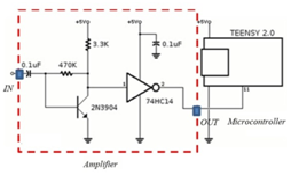Main Article Content
Abstract
Salah satu penyebab kecelakaan jalan raya adalah cara mengemudi yang tidak tepat, misalnya melebihi kecepatan maksimal yang diijinkan. Ketika kendaraan terjadi kecelakaan dapat menimbulkan ledakan yang sangat besar, seperti yang terjadi pada kasus mobil tangki pengangkut bahan bakar. Melihat permasalahan ini perlu solusi untuk memonitor cara mengemudi (driver behaviour). Metode yang diterapkan dengan aplikasi Electronic Control Unit (ECU) security system. Sistem ini dihubungkan dengan inputan Vehicle Speed Sensor (VSS) yang dibangkitkan oleh transmisi dan Thorttle Position Sensor (TPS) dibangkitkan oleh katup throttle valve. Sebuah microcontoller dan GPRS shield digunakan untuk mengirimkan pesan pada pemilik dan pengemudi kendaraan. Hasil yang diperoleh, saat kendaraan berjalan di atas kecepatan 60 km/jam, sistem dapat mengirimkan informasi tanda bahaya melalui sms ke ponsel pemilik kendaraan dan pengemudi.
Keywords
ECU security system
Controller
Sensor
Signal
Driver behaviour
Article Details
References
-
[1] P. George, “Investigation of road accident severity per vehicle type Yannis,” Transportation Research Procedia, vol. 25, pp. 2081–2088, 2017.
[2] E. Commission, “Mobility and transport Road Safety,” European Commission, 2018. .
[3] B. Jia, G. Lu, Y. Wang, and G. Yu, “The Measurement for Performance Parameter of Automobile Braking System with Electronic Vacuum Booster,” Procedia - Social and Behavioral Sciences, vol. 96, no. Cictp, pp. 2058–2065, 2013.
[4] J. Liu, Y. Li, and E. Zio, “A SVM framework for fault detection of the braking system in a high speed train,” Mechanical Systems and Signal Processing, no. October, pp. 0–1, 2016.
[5] T. K. Bera, K. Bhattacharya, and A. K. Samantaray, “Evaluation of antilock braking system with an integrated model of full vehicle system dynamics,” Simulation Modelling Practice and Theory, vol. 19, no. 10, pp. 2131–2150, 2011.
[6] M. Mirzaei and H. Mirzaeinejad, “Optimal design of a non-linear controller for anti-lock braking system,” Transportation Research Part C, vol. 24, pp. 19–35, 2012.
[7] D. Andrikov, D. Andrikov, and D. M. C. P, “Design of flat wheel braking control system with three modes of motion : rolling , sliding , locking,” Procedia - Procedia Computer Science, vol. 103, no. October 2016, pp. 466–469, 2017.
[8] J. B. Cicchino, “Effectiveness of forward collision warning and autonomous emergency braking systems in reducing front-to-rear crash rates,” Accident Analysis and Prevention, vol. 99, pp. 142–152, 2017.
[9] M. Gregu, “if every car had autonomous emergency braking system for forward collisions avoidance,” 2017.
[10] H. Lü and D. Yu, “Advances in Engineering Software Optimization design of a disc brake system with hybrid uncertainties,” Advances in Engineering Software, vol. 98, pp. 112–122, 2016.
[11] A. A. Yevtushenko, M. Kuciej, and E. Och, “Temperature in thermally nonlinear pad – disk brake system ☆,” International Communications in Heat and Mass Transfer, vol. 57, pp. 274–281, 2014.
[12] M. Setiyo and S. Munahar, “AFR and fuel cut-off modeling of LPG-fueled engine based on engine, transmission, and brake system using fuzzy logic controller (FLC),” Journal of Mechatronics, Electrical Power, and Vehicular Technology, vol. 8, pp. 50–59, 2017.
[13] A. Triwiyatno and E. W. Sinuraya, “Smart Controller Design of Air to Fuel Ratio ( AFR ) and Brake Control System on Gasoline Engine,” 2013.
[14] A. (2016). Andria, G., Attivissimo, F., Di Nisio, A., Lanzolla, A. M. L., & Pellegrino, “Development of an automotive data acquisition platform for analysis of driving behavior. , 93, 278-287.,” Measurement, vol. 93, pp. 278–287, 2016.

